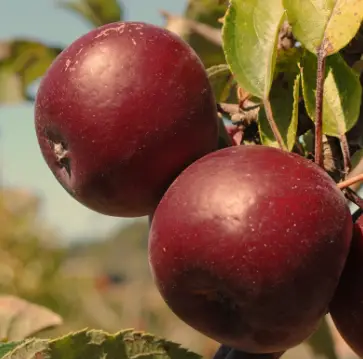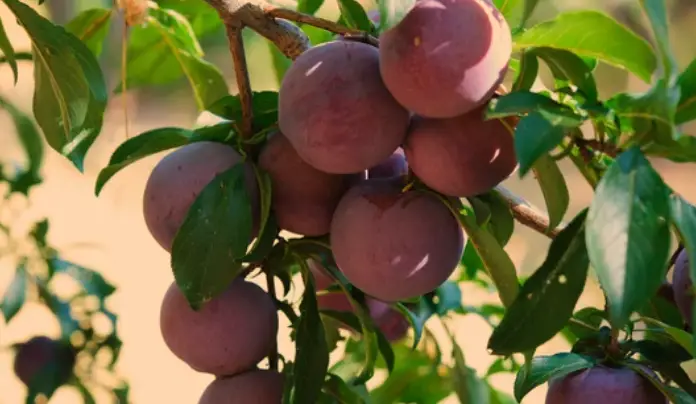An apple tree variety known as Arkansas black apple trees was first cultivated in Benton County, Arkansas, in the middle of the 19th century.
These trees are renowned for their distinctive looks, tastes, and textures.
The fruit produced by Arkansas black apple trees has a waxy skin, a firm, crisp texture, and a dark crimson to virtually black color.
The fruit’s acidic, somewhat sweet flavor makes it a popular ingredient in baking and cider production.
The hardy Arkansas black apple tree can withstand both hot summers and chilly winters. Compared to other apple varieties, it blossoms later, making it less susceptible to potential damage from spring frosts.
The tree is a popular option for both commercial orchards and backyard growers because it is resistant to several common apple diseases.
Since the fruit from the Arkansas black apple tree can be preserved for several months and is normally harvested in October, it is a well-liked option for winter baking and cooking.

Arkansas Black Apple Trees
History of Arkansas Black Apple Trees
Origins
Arkansas Black Apple Trees are a variety of apple trees that originated in the mid-19th century in Arkansas, United States. The exact origin of these trees is unknown, but it is believed that they were first discovered as a chance seedling in Benton County, Arkansas. The apple tree was then propagated and grown locally in Arkansas, and it became popular among the local farmers due to its unique characteristics.
The Arkansas Black Apple Tree is a late-season apple that is usually harvested in October. The apple is medium in size and has a dark red to black color when fully ripe. The flesh of the apple is firm, crisp, and juicy, with a sweet and tart taste. The apple is also known for its excellent storage qualities, and it can be stored for up to six months without losing its flavor or texture.
Spread Across America
The Arkansas Black Apple Tree gained popularity among the local farmers in Arkansas, and it was soon introduced to other parts of the United States. The apple tree was first introduced to California in the early 1900s, where it became popular among the apple growers due to its excellent storage qualities and unique flavor.
Today, the Arkansas Black Apple Tree is grown in many parts of the United States, including California, Washington, Oregon, and New York. The apple is also exported to other countries, including Canada and Japan.
In conclusion, the Arkansas Black Apple Tree is a unique variety of apple tree that originated in Arkansas in the mid-19th century. The apple tree is known for its excellent storage qualities, unique flavor, and dark red to black color when fully ripe. It has gained popularity among the local farmers in Arkansas and has spread across America and other parts of the world.

Characteristics of Arkansas Black Apple Trees
Physical Attributes
Arkansas Black apple trees are known for their distinct physical characteristics. The tree is medium-sized and has a spreading growth habit. The bark of the tree is dark and rough, and the leaves are medium-sized and oval-shaped. The flowers of the tree are white or pink and bloom in the spring. The fruit of the tree is medium-sized and has a round or slightly oblong shape. The skin of the fruit is dark red to almost black in color and has a waxy texture. The flesh of the apple is yellow and firm.
Taste Profile
Arkansas Black apples are known for their unique taste profile. The flavor of the apple is complex and has a balance of sweet and tart notes. The apple has a crisp and juicy texture that makes it perfect for eating fresh or for use in cooking. The apple has a long shelf life and can be stored for up to six months without losing its flavor or texture.
In conclusion, Arkansas Black apple trees have distinct physical attributes and a unique taste profile that make them a popular choice for growers and consumers alike.

Growing Arkansas Black Apple Trees
Cultivation Requirements
Arkansas Black apple trees thrive in a temperate climate and require specific growing conditions to produce high-quality fruit. Here are some cultivation requirements to keep in mind when growing Arkansas Black apple trees:
- Soil: Arkansas Black apple trees prefer well-draining soil with a pH between 6.0 and 7.0. The soil should be rich in organic matter and have good water-holding capacity.
- Sunlight: Arkansas Black apple trees require full sun exposure to produce high-quality fruit. They should receive at least six hours of direct sunlight each day.
- Water: Arkansas Black apple trees require regular watering, especially during the growing season. The soil should be kept moist but not waterlogged.
- Pollination: Arkansas Black apple trees require cross-pollination to produce fruit. Planting two or more trees of different varieties is recommended.
Pruning and Maintenance
Pruning and maintenance are essential for the health and productivity of Arkansas Black apple trees. Here are some tips for pruning and maintaining your trees:
- Pruning: Prune your Arkansas Black apple trees during the dormant season to remove dead, diseased, or damaged wood. Thin out crowded branches to improve air circulation and sunlight penetration. Prune to shape the tree and encourage fruit production.
- Fertilizing: Fertilize your Arkansas Black apple trees annually with a balanced fertilizer. Apply in early spring before new growth appears.
- Pest and Disease Control: Monitor your Arkansas Black apple trees for common pests and diseases, such as apple scab and codling moth. Use appropriate control measures, such as insecticides and fungicides, as needed.
- Harvesting: Harvest Arkansas Black apples when they are fully ripe, usually in late October or early November. Store the fruit in a cool, dry place to extend its shelf life.
By following these cultivation requirements and maintaining your Arkansas Black apple trees, you can enjoy a bountiful harvest of delicious, high-quality fruit.

Uses of Arkansas Black Apples
Culinary Uses
Arkansas Black apples are known for their firm texture and tart, sweet flavor. They are excellent for eating fresh, but also hold up well in cooking and baking. The apples’ dark red skin and flesh make them a visually striking choice for use in recipes.
Some popular culinary uses for Arkansas Black apples include:
- Pies and tarts: The firm texture of Arkansas Black apples makes them ideal for use in pies and tarts. Their tart flavor pairs well with sweet ingredients like sugar and cinnamon.
- Applesauce: Arkansas Black apples make a flavorful and colorful applesauce. The apples’ dark red color gives the sauce a unique hue.
- Salads: Sliced Arkansas Black apples can add a sweet-tart crunch to salads. They pair well with ingredients like arugula, goat cheese, and walnuts.
Cider Production
Arkansas Black apples are also commonly used in cider production. The apples’ high tannin content and tart flavor make them a popular choice for hard cider.
To make cider from Arkansas Black apples, the fruit is first pressed to extract the juice. The juice is then fermented with yeast, which converts the sugars in the juice to alcohol. The resulting hard cider can be enjoyed on its own or used as a mixer in cocktails.
Overall, Arkansas Black apples are a versatile fruit that can be used in a variety of culinary applications. Their unique flavor and appearance make them a popular choice for both home cooks and professional chefs alike.
Conservation and Sustainability of Arkansas Black Apple Trees
Arkansas Black Apple Trees are a unique and valuable part of the agricultural heritage of Arkansas. To ensure that these trees continue to thrive and provide benefits for future generations, conservation and sustainability efforts are essential.
One important aspect of conservation is preserving genetic diversity. Arkansas Black Apple Trees have a distinct genetic makeup that sets them apart from other apple varieties. To maintain this diversity, it is important to conserve a variety of Arkansas Black Apple Trees, including those grown in different regions and under different conditions.
Sustainability is also crucial for the long-term health of Arkansas Black Apple Trees. This includes using environmentally friendly practices such as integrated pest management and organic fertilizers. By minimizing the use of harmful chemicals, farmers can reduce the impact on the environment and protect the health of the trees.
In addition, sustainable practices can also improve the quality of the apples themselves. By using natural methods to control pests and diseases, farmers can produce healthier, more flavorful fruit that is free from harmful residues.
Overall, conservation and sustainability efforts are essential for the continued success of Arkansas Black Apple Trees. By preserving genetic diversity and using sustainable practices, farmers can ensure that these trees will continue to provide benefits for generations to come.
Conclusion
In conclusion, Arkansas Black apple trees are a valuable addition to any orchard. They are a hardy and disease-resistant variety that can produce high-quality fruit with a unique flavor and texture.
While they may take longer to mature and produce fruit compared to other apple varieties, the wait is well worth it. The apples have a long shelf life and can be stored for several months without losing their flavor or texture.
When it comes to planting and caring for Arkansas Black apple trees, it is important to choose a suitable location with well-draining soil and adequate sunlight. Regular pruning and fertilization can help ensure healthy growth and a bountiful harvest.
Overall, Arkansas Black apple trees are a great choice for anyone looking to add some variety to their apple orchard. With their unique flavor and texture, they are sure to be a hit with apple lovers everywhere.




